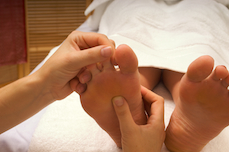The following reflexology maps show the links between the areas of the feet and the associated body area.
Archive for the ‘reflexology’ Category
Reflexology Maps
Friday, July 9th, 2010A History of Reflexology
Friday, August 21st, 2009Reflexology was the inspiration for my becoming a therapist. I was so impressed by the relaxation and stress relief that I experienced after receiving treatments that I decided to train myself.
History of Reflexology
Reflexology does not have an exact origin, throughout history many diverse cultures have been working on the feet to affect overall health.

Amanda At Work
In Egypt the tomb of Ankhmahor, physician to the king, has wall carvings dated 2330 BC, which include scenes of pressure massage on the feet. Pressure techniques on the feet have been performed as part of Ayevedic treatments in India for over 5000 years. Chinese Traditional Medicine also incorporates foot massage and zone theory, Eastern philosophies see the individual being as a microcosm of the universe and the feet as a microcosm of the individual being.
It is thought that Indian techniques travelled with Buddhist monks from India to China at the end of the 100’s AD and later through China to Japan. Near Ziaan, in China, a stone carving of Buddha’s footprint was preserved in a Buddhist temple. The carving is identical to footprints in India and Japan.
Western reflexology is closely linked with the Inca and Mayan tribes of America. Zone Therapy, in which the body is divided into 10 vertical zones, was practiced in Europe in the 1500’s. In 1913 Zone Therapy was rediscovered by Dr Fitzgerald an ear, nose and throat surgeon, who found that the whole zone was affected when pressure was applied to a specific point in the same zone. Fitzgerald also used Mayan engravings showing reflexology points as part of his treatments. Dr Shelby Riley, a colleague of Fitzgerald, produced diagrams of the foot reflexes. Eunice Ingham, Riley’s assistant, researched and worked with the ancient reflexes and evolved the reflexology maps and techniques that are still used today.
Since Doreen Bayley, a student of Eunice Ingham, introduced reflexology into Britain in the 1960’s it has been growing in popularity. Many research projects have been initiated in recent years, through organisations such as the Association of Reflexologists and also through funding by the Swiss and Danish governments.
Reflexology is equally beneficial for emotional and physical conditions and continues to be one of my favourite treatments to give and receive!




